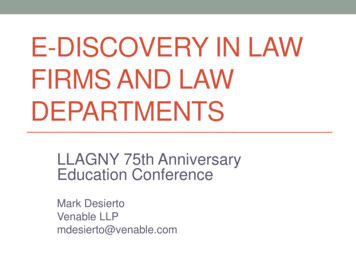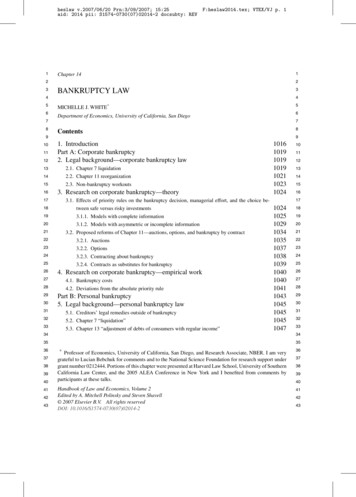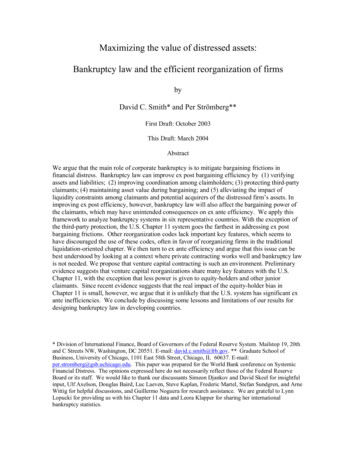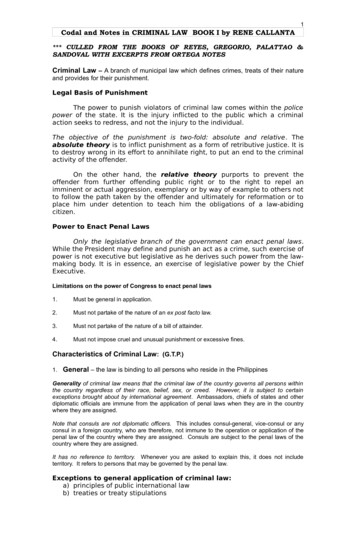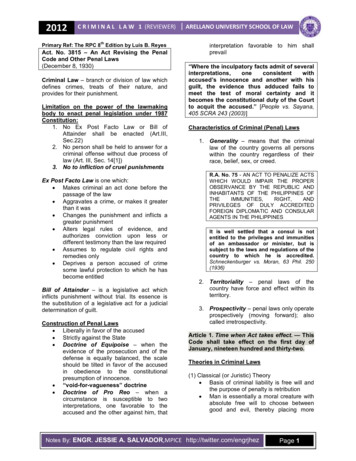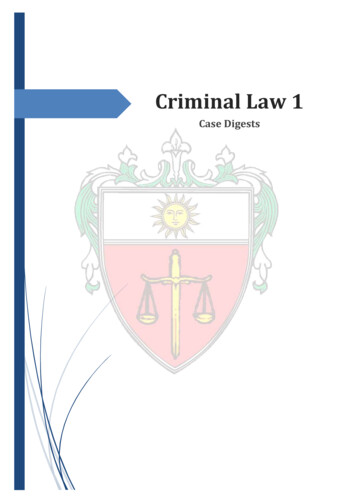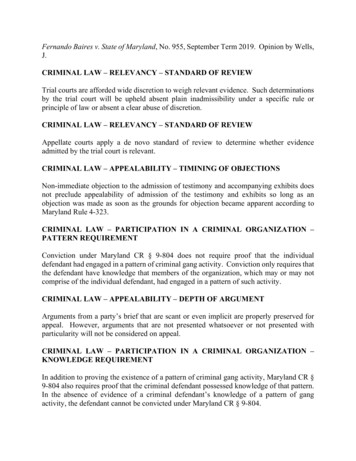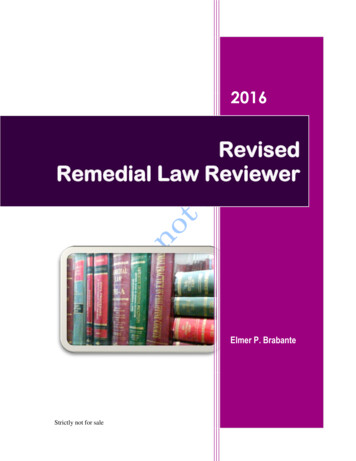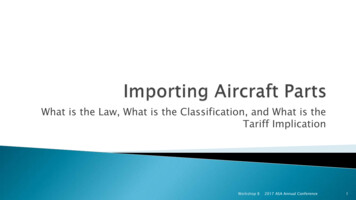
Transcription
What is the Law, What is the Classification, and What is theTariff ImplicationWorkshop B2017 ASA Annual Conference1
Constitution gives Congress the right to lay and collect duties.Art. 1, Sec. 8, Cl. 1Import tariffs and duties were originally the only way for thefederal government to raise revenue Also used to advance policy objectives Origins date to 1789 as the U.S. Customs ServicePost-9/11 was folded into Homeland Security as U.S. Customsand Border ProtectionCustoms plays a role in enforcing a wide range of laws;largest federal law enforcement agencyWorkshop B2017 ASA Annual Conference2
Duty or Tariff? Duty is the tax or fee charged by the government of the importer Tariff is a list of products and corresponding duties The terms are often used interchangeably (i.e., referring to theHarmonized Tariff Schedule as “customs duties”)Workshop B2017 ASA Annual Conference3
U.S. Customs and Border Protection Generates revenue by assessing and collecting duties, taxes and feesincident to international trade Controls, regulates, and facilitates movement between U.S. and othernations Detect, interdict, and investigate fraudulent and other illegal traderelated activities Bureau of Alcohol Tobacco Firearms and Explosives Permanent import of USMIL defense articles U.S. Census Bureau Collects and reports data on importsWorkshop B2017 ASA Annual Conference4
U.S. Census Bureau (outbound transactions)U.S. Commerce Bureau of Industry and Security Export returns of CCL articles U.S. State Department – Directorate of Defense Trade Controls Export returns of USML articles U.S. Treasury – Office of Foreign Assets Control Sanctions programs Securities and Exchange Commission FCPA and Conflict Mineral IssuesWorkshop B2017 ASA Annual Conference5
Ensuring articles are entered legallyEntering imported articles under the correct (and best)classificationMinimizing tariffs and dutiesMinimizing export burdens (if returning to customer)Workshop B2017 ASA Annual Conference6
Each Agency with jurisdiction over the import can levy finesand other penalties in the case of a violationCustoms seizure and forfeiture of improperly entered goodsU.S. Department of Justice enforces criminal provisionsWorkshop B2017 ASA Annual Conference7
Undervaluation of goods upon entry Or improper “informal entry” Inaccurate country of origin markingMisclassification of goodsFailure to pay antidumping or countervailing dutiesWorkshop B2017 ASA Annual Conference8
19 U.S. Code § 1592 It does not matter If the US loses money It does not matter if you had a fraudulent intent You can be penalized for negligence! Maximum penalties Fraud - value of the merchandise Gross negligence – 4x the lawful duties or 40 percent of the dutiablevalue Negligence – 2x the lawful duties or 20 percent of the dutiable value Penalties can be mitigated through prior disclosure Contact an attorney to guide you through the processWorkshop B2017 ASA Annual Conference9
Permanent import without a license 27 C.F.R. § 447.61-62: Willful import without a permit or false statements inregistration or permit application up to 1,000,000 and/or 10 years in prison 27 C.F.R. § 447.63: Knowingly imports or transacts in article w/o permitsubject to 10,000 and/or 5 years and forfeiture of article Temporary import without a license 22 C.F.R. 127.10: Civil penalty up to 1,111,908 Failure to report data to Census 19 CFR § 141.61(e) of the CBP regulations: penalty procedures relating toerroneous statistical information shall not be invoked against any person whoattempts to comply with the statistical requirements; deliberate attempt toavoid penalized per 19 U.S.C. § 1592Workshop B2017 ASA Annual Conference10
Imports laws and regulations are a complex webWork with professionals to help you through the process Common carriers (shippers) Customs brokers Legal counsel Don’t be afraid to ask questions of your import partners orcall Customs directly CBP INFO Center phone number: 877-227-5511Workshop B2017 ASA Annual Conference11
Two-part entry process, or use Customs Form 7501 (EntrySummary) Customs Form 7501 is the most common way we will make entry Declare the tariff codes, entered value and the duty owed Value will typically be transactional costs (what did the buyer pay) Report to Census through ABI (or broker)Workshop B2017 ASA Annual Conference12
Importer of record must file entry documents with the port directorat the port of entry Two parts: show evidence that articles can be released by customs, andprovide data to accurately assess duty File Customs Form 3461 in advance (Entry/Immediate Delivery)Must show evidence of right to make entry Must provide Declaration Typically this is done by a licensed customs broker. When entered by a common carrier (most shipments) delivery to person filingentry summary and estimated duties is deemed evidence of right to makeentry. 19 C.F.R. § 141.11(b). Person in whose name entry is made, or their agent, must declare that articlewas purchased, value on invoice is true, all other statements on invoice aretrue. 19 C.F.R. § 141.19; 19 U.S.C. § 1485(a).Workshop B2017 ASA Annual Conference13
Importer of record must file entry documents with the portdirector at the port of entry Two parts: show evidence that articles can be released by customs, andprovide data to accurately assess duty and statistics Invoices Include an invoice for each shipment (19 C.F.R. § 141.81). Installmentshipments arriving within 10 days require only one invoice. (19 C.F.R. §141.82). This information allows customs to accurately determine and assessdutiesWorkshop B2017 ASA Annual Conference14
Contents of an InvoicePort of EntryTo whom and from whom merchandise was soldDetailed description of the merchandiseQuantityPurchase priceCurrencyAdditional charges upon merchandise (e.g., shipping, insurance) andrebates allowed Country of origin of merchandise Workshop B2017 ASA Annual Conference15
Additional contents Packing listsPaginated invoices (e.g., 1 of 3, 2 of 3 )In EnglishName of responsible individual (exporter)HTS Classification and Rate of DutyDeposit estimated duties with CustomsEntry summary (Form 7501) filed within 10 days of entryWorkshop B2017 ASA Annual Conference16
The traditional method of filing in advance and later filing anentry summary is not conducive to modern businessForm 7501 (Entry Summary) can be filed at the time of entry(19 C.F.R. § 142.3(b)). Serves as both entry and entry summary documents. Consolidates entry into one step Still must ensure invoice includes necessary elements This is the form your customs broker probably usesWorkshop B2017 ASA Annual Conference17
Must report data to Census Bureau (15 C.F.R. § 30.50) The CBP Form 7501 (Entry Summary) serves this purpose as well! Form can be submitted in paper format or through ABI CBP provides the data to Census, but Census may require the importeror customs broker provide information to confirm reported data ABI (Automated Broker Interface) Allows importers and customs brokers to submit data electronically toCBP and receive communications through Automated CommercialEnvironment (ACE) ACE is where AESDirect migrated last yearWorkshop B2017 ASA Annual Conference18
Proper imports can help us exportLicense exception 22 C.F.R. § 123.4(a)(1) allows you to temporarilyimport an ITAR-controlled article for service or repair and return itto the customer without a license When you file your Customs Form 7501 (or 3461) it must be notated “Thisshipment is being imported in accordance with and under the authority of 22CFR 123.4(a)(1)” and include a description and value of the articles beingimported Upon export file the export information with CBP, identify 22 CFR 123.4 asthe authority for the export, and provide the entry document number or acopy of the CBP document under which the article was imported. You must be registered with the DDTC to take advantage of this exceptionWorkshop B2017 ASA Annual Conference19
The Harmonized Tariff Schedule is a system for identifying andcategorizing all goods in trade for duty and statistical purposes.The HTS is based on the international Harmonized CommodityDescription and Coding System HTS Import Schedule B numbers are export codes administered by Census forexport tracking purposes. They are also based on the HarmonizedCommodity Description and Coding System Schedule B Export Undercarriage parts for civil aircraft HTS 8803.20.00.30 vs Schedule B 8803.20.00.10Workshop B2017 ASA Annual Conference20
Most aircraft parts are categorized under Chapter 88 of theHarmonized Tariff CodeSome commonly used tariff codes: 8802.40.00.90 – Used civil aircraft exceeding 15,000 kg8803.10.00.30 - Civil aircraft propeller parts8803.20.00.30 - Civil aircraft undercarriage parts8803.30.00.30 - Civil aircraft parts that do not fit into any other clauseEngines and engine parts are under Chapter 84 8411.12.40.00 – Turbojets and parts thereof exceeding 25kN thrust 8411.22.40.00 – Turboprops and parts thereof exceeding 1100 kwWorkshop B2017 ASA Annual Conference21
United States International Trade Commission: https://www.usitc.gov/tata/hts/index.htmWorkshop B2017 ASA Annual Conference22
Must be U.S. Goods Can be repaired/restored to original condition Cannot be advanced in value (significant alteration) 9801.00.1010 – Return of temporary exports: articles reimportedafter 3 years abroad9801.00.1012 – Temporary imports for maintenance: articlesreimported for repair and expected to be re-exported9801.00.1077 – US civil aviation goods returned (e.g. when sentfor foreign repair)9801.00.3000 – US aircraft engines, propellers, or their parts forwhich duty was previously paidWorkshop B2017 ASA Annual Conference23
§ 30.53 Import of goods returned for repair.Import entries covering U.S. goods imported temporarily for repair oralteration and reexport are required to show the following statement:“Imported for Repair and Reexport” on CBP-7501 or in the ABI entry. This works in conjunction with 9801.00.1012 When the goods are for reexport and meet all of the requirements forfiling the EEI file as usual except for the following: Report the value of the repairs, including parts and labor. Do not report the valueof the original product. If goods are repaired under warranty, at no charge to thecustomer, report the cost to repair as if the customer were being charged. Report Schedule B commodity classification code 9801.10.0000 for goodsreexported after repair.Workshop B2017 ASA Annual Conference24
Aircraft and their articles are typically imported duty-free intonations that have signed the Agreement on Trade in CivilAircraft The US is a signatoryAll the examples above can be imported duty free!BUT there are exceptions Tariff rates on some common articles can range from 1% to 9%Workshop B2017 ASA Annual Conference25
Joints, washers or the like of any materialArticles of vulcanized rubber other than hardrubberToolsPictures and mirrorsMost items of nuclear reactors, boilers,machinery and mechanical appliances, includingmachine tools and engines, pumps and toolsused in nuclear power generationEngines or motor parts consisting of taps,cocks, and valves for pipes or ball or rollerbearingsTransmission shafts and cranks, bearinghousings, housed bearings and plain shaftbearings, gears and gearing, ball or rollerscrews, and gear boxes Electrical machinery or equipment (e.g. motors,generators, some avionics)Optical, photographic, cinematographic,measuring, checking, precision, medical orsurgical instrumentsClocks and watchesBombs, missiles ,or other armsLamps or lighting fittingsBrushes of a kind used as parts of vehiclesParts of general use (wires and cables, chains,tube or pipe fittings, locks, clasps, springs,castors, automatic door-closers, mountings,frames, mirrors, sign plates or other placards,washers, certain fasteners (like nails, tacks,drawing pins, staples, screws, bolts, nuts, coachscrews, screw hooks, rivets, cotters, and cotterpins), and closures like buckles or hooks) madefrom metal or plasticWorkshop B2017 ASA Annual Conference26
The structure of the transaction can affect your tariff rates A used aircraft ferried into the U.S. for part out may be entered dutyfree (HTS 8802.40.00.90) Same aircraft parted out overseas may result in certain parts beingsubject to tariff on import Know what you are trying to achieve and calculate accordinglyWorkshop B2017 ASA Annual Conference27
TC holder imported experimental parts as civil aircraft parts Parts intended for use in test engines run in cells on the ground Customs said articles were HTS 8411.91.9080 and dutiable at 3.7% TC holder argued civil aircraft parts duty free under Agreement onTrade in Civil Aircraft The HTC note and the Agreement both required parts to be importedfor “use in civil aircraft” TC holder argued that parts didn’t have to be installed on civil aircraft,just couldn’t be installed on military aircraftWorkshop B2017 ASA Annual Conference28
Court agreed with Customs The HTC general note states “the imported article has been imported for usein civil aircraft, [and] that it will be so used.” Court explained that using civil-eligible articles on the ground for test andincorporation in test cells didn’t satisfy the “use in civil aircraft” requirement.The articles were therefore dutiable NOTE: The HTS Code the court referenced does not currently exist.The HTS is revised annually!United Tech. Corp. v. United States, 315 F.3d 1320 (Fed. Ct. App.2003).Workshop B2017 ASA Annual Conference29
Lessons: Customs has wide latitude to assign classifications Make sure you know what is required to enter duty free Stay current Entry isn’t the end of the story – make sure the transaction iscompleted as stated upon entryWorkshop B201
When you file your Customs Form 7501 (or 3461) it must be notated “This shipment is being imported in accordance with and under the authority of 22 CFR 123.4(a)(1)” and include a description and value of the articles being imported Upon export file the export information with CBP, identify 22 CFR 123.4 as the authority for the export, and provide the entry document number or a copy of the .

